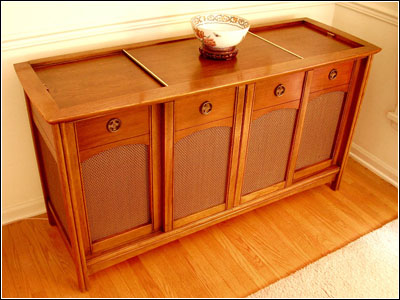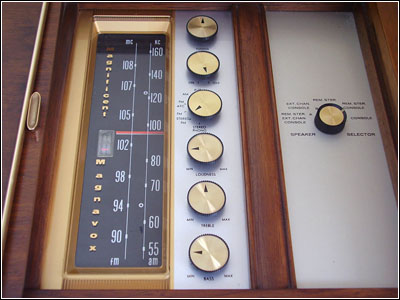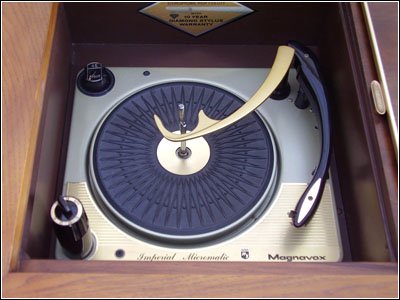Of Old Radios And Related Items--Published Monthly
Our Classic Magnavox Console
Scooter's LegacyBY CHRIS JONES
Web Edition
Fortunately for those large stereo consoles of the 1950s-1960s, there are still collectors like Chris Jones able and willing to give them houseroom and to repair them when necessary. Chris has also found a novel way to use his set -- as a dog deterrent. (Editor)
Our beloved, late dog Scooter seemed to think our living room, which we seldom used, was his domain. He had a habit of stealthily "marking" various spots when no one was looking. As one step to help solve this problem I thought, perhaps if we used the room more, he'd view it less as his, and perhaps we'd use it more if there were a music system there. Given the décor, the thing that seemed like it might look best in the room was -- dare I say it -- a stereo console.
Ah yes, the stereo console. I think vintage electronics enthusiasts lie in two different camps with regards to these sets. One camp holds them in derision as corpulent, electronic slugs squatting in the living room, laboring under their own bulk and producing, at best, mediocre sound. The other probably harbors warm, fuzzy feelings of growing up in a household with one that was an object of pride and provided a family entertainment focal point, whether a TV was included or not. They are the ones that, if they still have the family console, break out the Christmas LPs to play on it during the holidays.
As you might suspect. I'm in the latter camp. When I was growing up, just as some fathers were "Chevy, Ford men" or "Oldsmobile men" with respect to the family cars, my dad was a "Magnavox man" when it came to stereo consoles. So, naturally that is what I had to have.
Figure 1. The Magnavox Model 1ST665S, ca 1962, a prized family possession.A Lucky Find
Since I was anxious to get something quickly, the initial unit I bought was a mid-1970s solid-state system with AM, FM-stereo, a record changer, and an eight-track! The cabinet was all photographic veneer and molded plastic overlay, but it looked OK in the house, and it sounded pretty good. I also connected a cassette deck so we had some type of semi-modern media.
This was fine for a while, but I gradually started craving a real vintage Magnavox -- a vacuum tube unit with the big side-firing woofers, horn tweeters, and solid wood cabinet. A call in response to a yard sale newspaper ad that mentioned a stereo console revealed that the seller had an old Magnavox.
Shown in Figure 1, the circa 1962 Model 1ST665S turned out to be just what I had in mind. Nearly five feet wide and in essentially mint condition, this obviously had been a prized family possession, lovingly cared for. It still had an original factory sticker on it, all the original paper work including manual, warranty, "hang" tags, and signed factory inspection (IBM punch card). Also inside was a short soft brush the late owner presumably used to dust the nooks and crannies. See Figure 2 (see print version). His daughter said she could still remember her dad getting the Magnavox from a big Rochester department store.
The Technical Details
Stereo consoles were made by many companies, including even Fisher Radio, and in spite of how some people view them today, they embody careful, clever engineering and quality components. This Magnavox, generally an up-market brand, is an example.
The controls, shown in Figure 3, include the typical tuning (flywheel, naturally), power, function, loudness, treble, and bass, but also a tuning meter and speaker selector. A screwdriver-adjustable balance control is reached through the center of the bass control's shaft. The function switch provides an "aux" position intended for a tape deck (record outputs are also included), but now handy for cassette or CD use. Behind these controls are three chassis of electronics (tuner/preamp, FM multiplex decoder, power amp/supply), a record changer, and a speaker system.
The tuner uses an RF stage and a 3-gang condenser on both AM and FM. It has a 6EA8-based separate oscillator and mixer stage on FM with an AFC varicap, but a single converter for AM. Two IF stages are used for FM, and one for AM. A ratio detector with a 6AL5 dual diode provides FM demodulation, while a 6BA6-based AM detector incorporates a 10 kHz audio notch filter to suppress adjacent channel heterodynes. The tuning meter is in the plate circuit of the first IF amp. The tuner is essentially the same circuit used in Magnavox's spare-no-expense "Concert Grand" model that John Eckland described in his September 2007 ARC Magnavox article.
The FM multiplex decoder uses three tubes in a textbook scheme that seems to have been short-lived, as the service data shows a completely different design one year later.
The preamp has a single 6EU7, a much lower noise choice than the typical 12AX7, but with totally passive/non-feedback volume and tone controls. Pretty basic. The bass control is unusual in that it not only varies the response, but also blends the two channels' lows together as bass is increased.
Figure 3. The controls are the typical tuning, power, function, loudness, treble and bass. Also included are a tuning meter and speaker selector offering five main and remote speaker combinations.The power amp incorporates a 6EU7 for the driver and phase inverter and push-pull, cathode-biased 6BQ5s at 350V in each channel providing 10 watts just at clipping by my measurements. Magnavox advertising for similar models rates them at 15 watts/channel so that may apply to this one also.
Power ratings were subject to both exaggeration and obfuscation due to one-upmanship, and the various rating methods: rms, peak, IHF (Institute of High Fidelity) music power (substitutes an essentially regulated supply for the actual supply), and differing test conditions. The supply powers the entire console using a 5U4 with a choke, and has a hum balance control.
The changer, shown in Figure 4, is actually a British Collaro with an Electro-Voice ceramic cartridge. The cartridge, which an April 1959 Radio & TV News product review judged "clean and crisp" over 30 Hz-15 kHz, is rated to track at six grams, although I've also seen three grams in Magnavox literature. The changer incorporates a muting switch that eliminates noise during cycling and also a power switch which shuts the console off after the last record. When I had the changer removed, I found a label on the bottom with actual written production test data for rumble and, I think, wow or flutter.
Speakers were always touted as a Magnavox strong point. Each channel uses a 15-inch, 4-ohm side firing woofer with, I'd estimate based on Magnavox advertising, a 2-pound magnet. The side-mounted woofers were a Magnavox signature feature, and, since bass is nondirectional, they work fine.
The 1000 Hz exponential horns for the middle/upper frequencies are impressive also, with drivers that look only slightly less complex than a Swiss watch. The speakers are driven via an L-C-R crossover network, not just a quick-and-dirty cap in series with the tweeter. There's no unusual baffling and the speakers are just mounted in the cabinet -- something that likely contributes to the basso-profundo sound reputation of these things.
Just to touch briefly on the cabinet, this particular model seems made also (or alternately) to contain a TV as the right-hand control panel appears to provide enough space to take a TV tuner dial. In addition, the center section of the console, behind the sliding doors, which now provides record storage with wire rack and a shelf, looks sized for a TV chassis.
The cabinet is solid wood (all walnut, I think) or actual veneer on plywood for the flat surfaces, any trim that looks like metal actually is metal, and the tuner dial is glass. The most charming feature, however, is that set into the front rail below the doors is a small indicator that glows red when the console is on.
Figure 4. The changer is a British Collaro with an Electro-Voice ceramic cartridge.So How Good Is It?
How does the Magnavox console compare to a component system? An interesting exercise is to compare the tube count with a component receiver. A highly regarded contemporary one was the Fisher 500B/C. The 1963 500C was a 33-watt/channel RMS, FM-stereo receiver with an array of features and so provides a good high-end benchmark. The Fisher uses 20 tubes: seven in the tuner, three in the multiplex decoder, four in the preamp, and six in the PA. The Magnavox has 18: seven in the tuner (but two are used for AM), three in the decoder, one in the preamp, and six in the PA, plus one rectifier. Functionally, the difference is that the Magnavox uses two fewer IF stages in the tuner, and three less preamp stages, with the 500C providing additional gain for a magnetic cartridge or tape head, and also negative feedback on each stage. The Magnavox runs its single 6EU7 flat out.
How about specs? The Fisher is rated to be flat within 2 dB from 5 Hz to 45 kHz and have 0.7% IM distortion at 30 watts. I measured the Magnavox's PA as within 3 dB from 25 Hz to 46 kHz, not bad, but with IM distortion of 2.4% at 10 watts. The Magnavox's overall response with its fixed loudness contour was interesting with a whopping 16 dB boost at 100 Hz and 6 dB at 18 kHz (at nominal control settings but bass close to minimum). Interestingly, the loudness circuit with two taps on the pot and five components is far more complex than the 500C.
The Fisher's price was $390 while the Magnavox's was about $500 and, of course, included the changer, speakers and cabinet. An overview in the February 1962 issue of (I only buy it for the articles) Playboy strove to define a $500 component system, but the best they could do was $650 for a Sherwood/Garrard/Jensen line-up with cabinet.
The sound is actually pretty good. Of course, there's the booming bass to contend with, so I keep the bass turned down, except when playing records where it is needed to balance the sound. The exponential horns sound crisp and clear. I think the console is at its best with monaural FM, as the multiplex circuitry restricts the high frequencies somewhat in FM stereo. Nevertheless, it's still pleasant to listen to. With a typical FM twin-lead antenna mounted behind the living room drapes, the tuner picks up a favorite station across Lake Ontario. LPs sound pretty good also -- the aforementioned Christmas records, of course, but also rock, jazz, and classical material.
Problems Along the Way
We've had the Magnavox probably 15 years, and there has been a variety of issues during that time. It was working when first brought home, except as I recall for a marginal idler in the changer. Work done, in no particular order, was the following:
- Tuner and multiplex decoder alignment.
- Replacement of out-of-tolerance resistors in the multiplex decoder which seemed to cause the decoder to drift out of alignment frequently.
- Rebuilt changer idler (by an A.R.C. advertiser) to correct slippage.
- New cartridge (also from an A.R.C. advertiser!) as the original developed severe audible distortion that was also visible on a scope while playing a CBS test record. Also set stylus pressure.
- Changer cleaning and relube -- just a precaution while it was out for the cartridge replacement.
- New caps (same value) for the crossover as a step toward slightly more highs.
- New output tubes (just because, and 6BQ5s were still cheap then).
- New driver/phase inverter sockets in the PA. This corrected the most frustrating problem -- intermittent static in one channel or the other. After repeatedly thinking I had noisy tubes, or dirty sockets, or searching for a noisy R or C over a couple years, I replaced the two sockets and -- ta-da! -- the noise was gone and has stayed that way.
As John Eckland mentioned in his article, consoles of this vintage aren't exactly fun to work on. The PA is pretty straightforward to remove, but things go downhill from there with the multiplex decoder in a tight location, the changer with hardly any working clearance below it for removal (or there's a trick I couldn't figure out) and the tuner, as John said, is the pits!
Pleasant Listening!
We use the Magnavox regularly for FM-stereo background music or playing LPs for entertainment or dancing and get a lot of enjoyment out of it. In spite of consoles' "likely orphan," "can't-even-give-it-away" collectible status, based on my experience with ours, units from the early days of stereo before the transition to solid-state (but some early transistor ones also) can be beautiful pieces of furniture. They can also provide pleasant sound for general family use.
And what about Scooter you may ask? Our increased room use didn't make any difference, but what did was a pair of black electric eye units purchased with a box of junk at a RadioShack. With one placed at each living room entrance we could immediately hear if he transgressed and reprimand him. He learned the room was off limits remarkably quickly, and the technique worked so well that when a second off-limits area arose, I just painted a block of wood black and set it there. Scooter thought it was another electric eye unit and stayed out.
References:
Eckland, John. "The Magnavox Company," Antique Radio Classified, September 2007.
"Fitting Out for Twin-Eared Sounds," Playboy, February 1962, pp. 46-50, 116-117.
Magnavox Service Manual 6264, Concert Grand Models 1ST800F & 1ST801F, 1959, The Magnavox Company, Service Department.
Magnavox Service Manual 6270, 70-01 F-M Multiplex Adapter Chassis, November 1961, incl. Supplement No. 1, November 1962, The Magnavox Company, Service Department.
Magnavox Direct Mail Brochure Form No. DM-1062.
Magnavox Direct Mail Brochure Form No. DM-1064.
Sams, Howard W. & Co. Photofact Folder 10, Set 623, Magnavox Chassis, d. 3-63.
Sams, Howard W. & Co. Photofact Folder 11, Set 623, Magnavox Chassis, d. 3-63.
Radio & TV News, April 1959, "Hi-Fi Product Test Report, E-V Stereo Cartridge," p47.
Vacuum Tube Valley, Issue 6, Winter 1997, "The Fisher 500 Family of Receivers -- The Start of a Generation", p 3-9.
Chris Jones is a recently retired electrical engineering director and has been interested in old radios since he was offered an Aeriola Senior about 25 years ago. He still tries to limit his acquisitions to those he can use in normal everyday living and recently has tended toward audio equipment and adding test gear to help keep the music playing.
|
[Free Sample] [Books, etc., For Sale] [Subscribe to A.R.C./Renew] [Classified Ads] [Auction Prices] [Event Calendar] [Links] [Home] [Issue Archives] [Book Reviews] [Subscription Information] [A.R.C. FAQ]URL = http://www.antiqueradio.com/Apr08_Jones_Magnavox.html Copyright © 1996-2008 by John V. Terrey - For personal use only. Last revised: March 1, 2008. For Customer Assistance please contact ARC@antiqueradio.com or call (866) 371-0512 toll free Pages designed/maintained by Wayward Fluffy Publications Antique Radio Classified |


